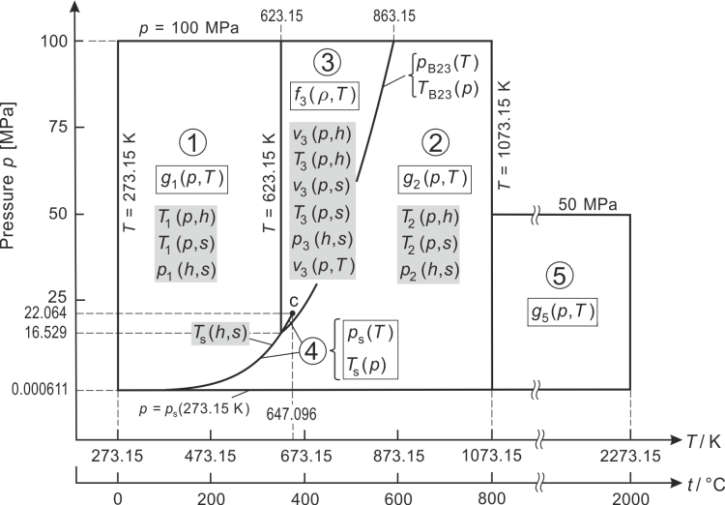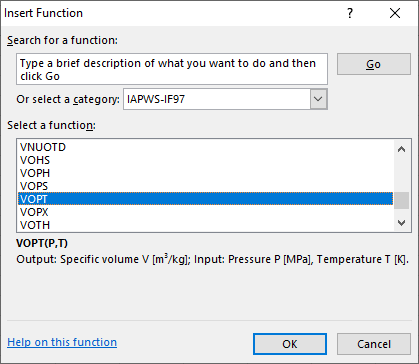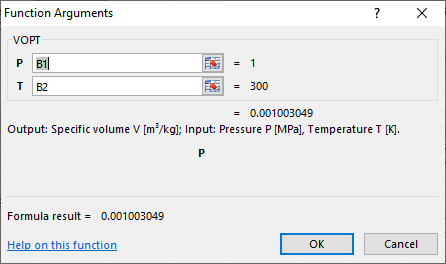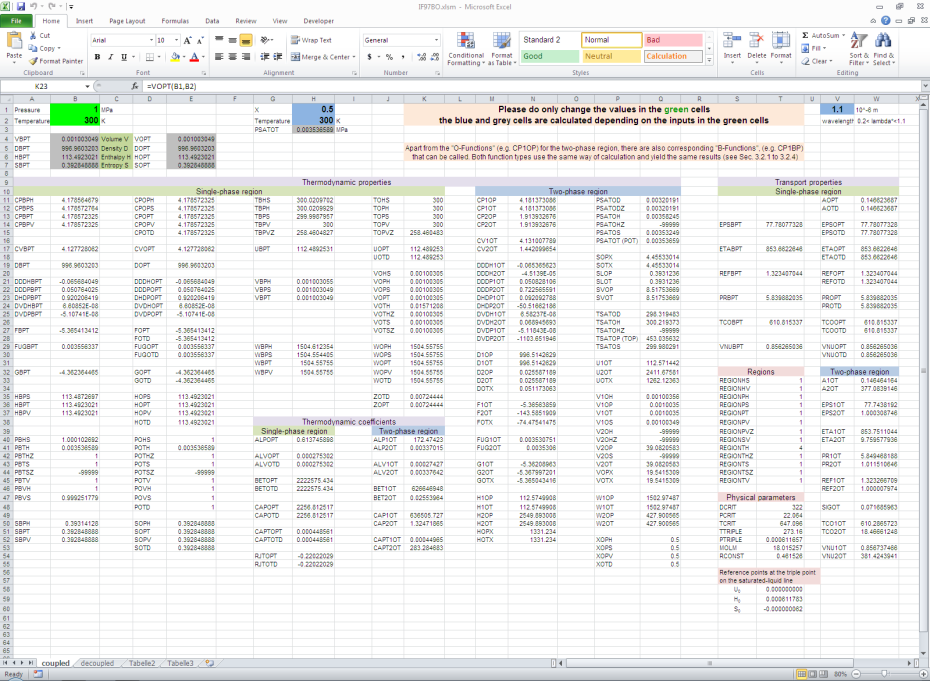1. Short information about IAPWS-IF97
The industrial formulation IAPWS-IF97 is the reference equation of state for water and steam for industrial use. A detailed description of the IAPWS-IF97 can be found here. Information about the use of this software package under the different Windows operating systems and Excel versions as well as about the integration of the available 32-bit or 64-bit Fortran DLL using Excel Add-Ins and 32-bit .NET DLL are given in Section 2.4 of this software description.
Detailed information about the current distribution channel by the engineering office Dr.-Ing. N. Kurzeja can be found there as well.
The Industrial Formulation IAPWS-IF97 consists of a set of equations for different regions, which covers the following range of validity:
0 °C ≤ t ≤ 800 °C, p ≤ 1000 bar (100 MPa)
800 °C < t ≤ 2000 °C, p ≤ 500 bar (50 MPa)

Structure and regions of IAPWS-IF97.
The figure above shows the five regions into which the entire range of validity of IAPWS-IF97 is divided. Regions 1 and 2 are both individually covered by a fundamental equation for the specific Gibbs free energy g(p,T), region 3 by a fundamental equation for the specific Helmholtz free energy f(ρ,T), and the saturation curve, corresponding to region 4, by a saturation-pressure equation ps(T). The high-temperature region 5 is also covered by a g(p,T) equation. These five equations, shown in rectangular boxes in the figure, form the so-called basic equations.
In addition to these basic equations, so-called backward equations are provided for regions 1 to 4. These backward equations were developed in the following combinations of variables: For regions 1 and 2 as equations of the form T(p,h), T(p,s), and p(h,s), for region 3 as equations of the form T(p,h), v(p,h), T(p,s), v(p,s), p(h,s) and v(p,T). The backward equation for the entire region 4 is a saturation-temperature equation Ts(p), which is mathematically completely consistent with the saturation-pressure equation ps(T). For the technically most important part of region 4 (s ≥ s(623.15 K)), there is a saturation-temperature equation of the form Ts(h,s). In the figure above, in addition to the (framed) basic equations, all of these types of backward equations (marked in grey) are assigned to the corresponding region of IAPWS-IF97.
With these backward equations, properties that depend on the input quantities (p,h), (p,s) and (h,s), in region 3 also on the input quantities (p,T), are calculable without iterations and thus very quickly.
A comprehensive description of the IAPWS-IF97 is given in the book
Kretzschmar, H.-J., Wagner, W., International Steam Tables - Properties of Water and Steam based on the Industrial Formulation IAPWS-IF97. Springer-Verlag (Berlin), 2019.
This book also contains the IAPWS equations for the most important transport properties and some other properties, three overview diagrams (Mollier h-s diagram, T-s diagram, log(p)-h diagram) and pressure-temperature diagrams with isolines of more than 25 properties. For more details (contents, sample pages, etc.) see here.
2. Software for IAPWS-IF97
On the basis of IAPWS-IF97, including all of the backward equations as well as the IAPWS equations for the transport properties and further properties, there is a software package called IAPWS-IF97BO for the calculation of a large number of properties. The software was specially developed with a view to optimal programming in order to achieve short computing times.
When applying the software, it is not necessary to know which region of IAPWS-IF97 the property to be calculated belongs to. Based on the given input quantities, the software automatically determines which equation of IAPWS-IF97 has to be applied.
With our software package IAPWS-IF97BO, 21 thermodynamic properties, five partial derivatives, five transport properties and three further properties of water and steam can be calculated.
2.1 Thermodynamic properties
Based on the corresponding equations of IAPWS-IF97 the following thermodynamic properties can be calculated:
Table 1 Calculable thermodynamic properties.
|
Symbol |
Thermodynamic properties |
|
p |
Pressure |
|
T |
Temperature |
|
v |
Specific volume |
|
ρ |
Density |
|
h |
Specific enthalpy |
|
s |
Specific entropy |
|
cp |
Specific isobaric heat capacity |
|
cv |
Specific isochoric heat capacity |
|
w |
Speed of sound |
|
u |
Specific internal energy |
|
f |
Specific Helmholtz free energy |
|
g |
Specific Gibbs free energy |
|
f* |
Fugacity |
|
z |
Compression factor |
|
x |
Vapour fraction |
|
αv |
Isobaric cubic expansion coefficient, αv = v–1(∂v/∂T)p |
|
αp |
Relative pressure coefficient, αp = p–1(∂p/∂T)v |
|
βp |
Isothermal stress coefficient, βp = – p–1 ∂p/∂v)T |
|
κ |
Isentropic exponent, κ = – (v/p) (∂p/∂v)s |
|
κT |
Isothermal compressibility, κT = – v–1(∂v/∂p)T |
|
µ |
Joule‑Thomson coefficient, µ = (∂T/∂p)h |
|
(∂v/∂p)h |
Partial derivative of volume with respect to pressure at constant enthalpy |
|
(∂ρ/∂p)h |
Partial derivative of density with respect to pressure at constant enthalpy |
|
(∂v/∂h)p |
Partial derivative of volume with respect to enthalpy at constant pressure |
|
(∂ρ/∂h)p |
Partial derivative of density with respect to enthalpy at constant pressure |
|
(∂h/∂p)T |
Partial derivative of enthalpy with respect to pressure at constant temperature |
All these properties can be calculated in the entire range of validity of IAPWS-IF97, see Sec. 1. Concerning region 4 (two-phase region), the properties ν, ρ, h, s, u, f, g and x can also be calculated within the two-phase region. The other properties can only be calculated on the phase boundaries (saturated-liquid line and saturated-vapour line) because they are not defined within the two-phase region.
2.2 Transport properties and further properties
The following transport properties and further properties can be calculated with the software:
Table 2 Calculable five transport properties
and three further properties.
|
Symbol |
Transport and further properties |
|
η |
Dynamic viscosity |
|
ν |
Kinematic viscosity, ν = η / ρ |
|
λ |
Thermal conductivity |
|
Pr |
Prandtl number, Pr = η cp/ λ |
|
a |
Thermal diffusivity, a = λ /(ρcp) |
|
ε |
Relative static dielectric constant |
|
n |
Refractive index |
|
σ |
Surface tension |
The internationally agreed equations for calculating these properties, which do not belong to IAPWS-IF97, are described in the book “International Steam Tables” mentioned at the end of Sec. 1 and in the corresponding IAPWS releases IAPWS R12-08 for the viscosity, IAPWS R15-11 for the thermal conductivity, IAPWS R8-97 for the static dielectric constant, IAPWS R9-97 for the refractive index and IAPWS R1-76(2014) for the surface tension, see http://www.iapws.org/. It should be noted that these equations are functions of temperature and density (not pressure). This fact has consequences for the necessity of iterations. The surface tension is a function of temperature only.
Except for the dielectric constant ε, all the other properties can be calculated in the entire range of validity of IAPWS-IF97, see at the beginning of Sec. 1. The range of validity of the equation for ε is limited to 873.15 K, but the equation can be reasonably extrapolated up to 1073.15 K. The surface tension σ(T) refers only to the two-phase region, region 4.
2.3 Combinations of input variables for calculating the several properties
2.3.1 Regions 1-5
For regions 1-3 and 5 (single-phase regions) and region 4 (two-phase region), all properties listed in Tables 1 and 2 can be calculated as a function of the pairs of input variables shown in Table 3. For region 5, properties for input variables other than (p,T) are calculated via iterations only; there are no backward equations. Properties in region 4 cannot be calculated for the combination (p,T) as input variables, because p and T are not independent of each other in this region.
Table 3 Possible combinations of
input variables for calculations in
regions 1 to 5; for region 4, (p,T)
cannot be used, see text above.
|
(p,T) |
(T,h) |
(ν,h) |
(h,s) |
|
(p,h) |
(T,s) |
(ν,s) |
|
|
(p,s) |
(T,ν) |
|
|
|
(p,ν) |
(T,ρ) |
|
|
The most important properties can be calculated directly from the functions in the software for the pairs of input variables listed in Table 3. The calculation of further properties as functions of all the pairs of input variables is possible by corresponding combinations of functions contained in the software.
2.3.2 Calculations of properties in region 4 (two-phase region)
For region 4 (two-phase region (0 < x < 1), saturation pressure ps, saturation temperature Ts, saturated-liquid line [('), x = 0, bubble line], saturated-vapour line [("), x = 1, dew line]), the properties in the left column of Table 4 can be calculated from the functions given in the software for all listed input variables.
Table 4 Calculable properties for the entire region 4 (saturated-liquid line,
saturated-vapour line and within the two-phase region) from the
corresponding functions listed in the software.
|
Calculable properties |
Input variables1 |
Explanations |
|
ps |
T, h, s, ρ, x |
1In addition to the input variables given here, the properties can also be calculated using the corresponding input variables listed in Table 3 [except for |
|
Ts |
p, h, s, ρ |
|
|
v, h, s |
(T,x), (p,x) |
|
|
ν, f, g |
(T,x), (p,x) |
|
|
x |
(p,h), (p,s), (p,v), (T,ρ) |
Those properties listed in Tables 1 and 2 that are not given in the left column of Table 4 cannot be calculated within the two - phase region (0 < x < 1) but only on the saturated-liquid line (x = 0) and saturated-vapour line (x = 1); these properties are not defined within the two - phase region
2.4 IAPWS-IF97 DLL and Excel Add-In for the calculation of thermophysical properties
For the integration of the IAPWS-IF97 into Windows-based standard programs, the software package IAPWS-IF97BO contains the dynamic link library (DLL) IF97BO.dll, optimized and built with the Intel Parallel Studio XE 2015 Composer Edition for Fortran (version 15.07.287). The DLL provides numerous functions that allow the calculation of all properties listed in Tables 1 and 2 for all combinations of input variables given in Tables 3 and 4.
The software allows whether the desired properties should be calculated using the backward equations contained in IAPWS-IF97, or only the basic equations with iterations should be used, if iterations are necessary for the calculation of the corresponding property. In this case, the backward equations are used to calculate the initial values, so that these iterations are significantly faster than without these initial values. The functions are called up using simple function names, which contain abbreviations for the desired property and the required input variables. For example, to calculate the specific enthalpy h for given values of pressure p and temperature T, the function HBPT is available for using the backward equations and the function HOPT is available for the calculation without the use of the backward equations.
In addition, the IAPWS-IF97BO software package, available in 32-Bit or 64-Bit, contains a Microsoft Excel Add-in that allows a simple integration of the DLL into Microsoft Excel. Since installing the IAPWS-IF97BO Excel Add-In adds all functions exported with the DLL to the standard Microsoft Excel function set, the desired thermodynamic and transport properties can be called either by direct input of the formula listed in the manual into an Excel spreadsheet or very conveniently with the help of the function wizard of Microsoft Excel.

Calling the IAPWS-IF97 function VOPT using the Excel function wizard

Entering the arguments for the function call VOPT
A simple access to the function calls offered by IAPWS-IF97BO software package for the thermodynamic state variables and the transport variables is of course also possible within Excel via VBA scripts written for own purposes, which can then be called as macro.
Furthermore, the IAPWS-IF97BO software package contains an import library file (IF97BO.lib) that allows to integrate the DLL into user specific Fortran and unmanaged Visual C++ applications.
All property functions of the DLL are described in detail in the MANUAL IAPWS-IF97_x86/x64.PDF that is part of the software.
As an example, the following screenshot of the reference spreadsheet IF97BO.xlsm shows the results of the calculation of all the properties for the temperature T = 300 K and the pressure p = 1 MPa. For T = 300 K, all properties on the saturated-liquid line and saturated-vapour line were calculated as well. For the vapour fraction x = 0.5, all properties that are defined within the two-phase region are also calculated. All these properties were calculated at once. This Excel reference spreadsheet contains all the function calls provided by the IAPWS-IF97BO software package and can therefore be used as a quick and simple calculator for the thermodynamic properties and transport properties of water and and steam. Of course, a user specific Excel spreadsheet can be designed with the desired IAPWS-IF97BO functions or any desired IAPWS-IF97BO functions can be called within Excel via a user specific VBA script.

Example screenshot of calculations with the software package IAPWS-IF97BO from within the Excel spreadsheet IF97BO.xlsm.
The 32-bit Version of IAPWS-IF97BO can be used on the 32-bit versions of Microsoft Excel (2003 ─ 2024/Microsoft 365) using the supplied Excel Add-In IF97BO.xla (for Excel 2003) or IF97BO.xlam (for Excel 2007 ─ 2024/Microsoft 365) on the various Windows operating systems [Windows 2000 or XP (32-bit), Windows Vista, Windows 7, 8 and 10 (32-bit/64-bit)].
The IAPWS-IF97BO software is also available with a 64-bit DLL that can be integrated into the 64-bit versions of Excel 2010 ─ Excel 2024/Microsoft 365 on the 64-bit operating systems from Windows XP to Windows 11 using the supplied 64-bit Excel Add-In IF97BO.xlam. Worksheets developed in a 32-bit version of Excel with IAPWS-IF97BO function calls can thus continue to be used in a 64-bit version of Excel without any changes.
In addition, a 32-bit .NET DLL of IAPWS-IF97BO is also available and can be integrated into the .NET programming languages (Visual C#, Visual C++ or Visual Basic) of Microsoft Visual Studio.
The software IAPWS-IF97BO is not free of charge and is distributed by the Engineering office Dr.-Ing. N. Kurzeja (Norbert.Kurzeja@rub.de).
Please note that an equivalent software package is also available for the reference equation of state GERG-2008 and for more than 95 pure substances by the software FluidCal. Further information on the entire software range can be found at https://www.thermo.ruhr-uni-bochum.de/thermo/wagner.html.en
Contact:
Engineering office Dr.-Ing. N. Kurzeja
feos-software
Hevener Mark 26
D-58455 Witten
Germany
phone: +49 (0)2302 279849
mobile: +49 (0)175 224 8598
Norbert.Kurzeja@rub.de
The engineering office works in the field of development and distribution of thermodynamic software as well as in research on calorimetric measurements of gross calorific values and on the behavior of pure fluids in the so-called critical area. Examples are the publications
Kurzeja, N., Span, R. Accurate measurements of the gross calorific value of methane by the renewed GERG calorimeter. Published within the Featured Collection of J. Phys. Chem. Ref. Data 48, 043103 (2019). https://doi.org/10.1063/1.5110054
Wagner, W., Kurzeja, N. Letter to the editor. Int. J. Thermophys. 32 (2011), 549-552. https://doi.org/10.1007/s10765-011-0945-7
Kurzeja, N., Tielkes, Th., Wagner, W. The nearly classical behavior of a pure fluid on the critical isochore very near the critical point under influence of gravity. Int. J. Thermophysics 20 (1999), 531-561. https://doi.org/10.1023/A:1022657121329
Wagner, W., Kurzeja, N., Pieperbeck, B. The thermal behavior of fluid substances in the critical region - experiences from recent pρT measurements on SF6 with a multi-cell apparatus. Fluid Phase Equilibria 79 (1992), 151-174. https://doi.org/10.1016/0378-3812(92)85127-T